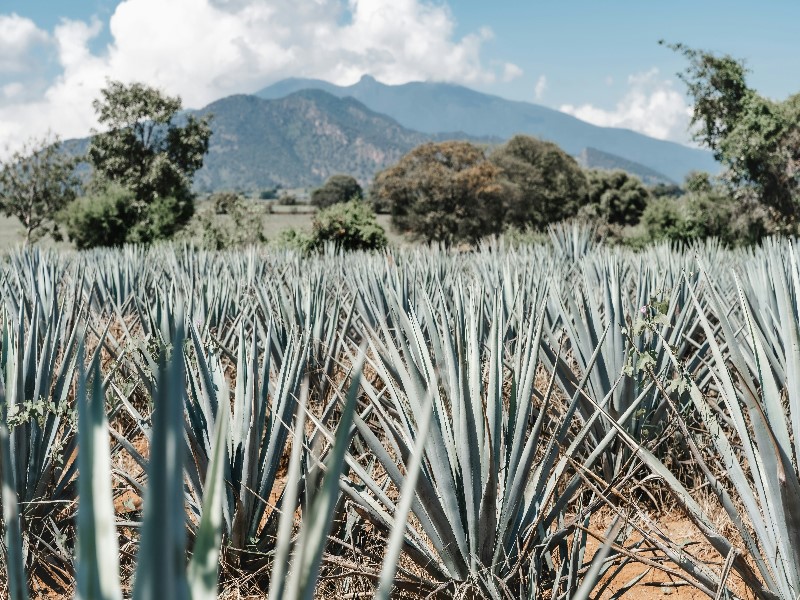
Agave: Desert Gem to Spirit Sensation
Before writing about agave, I’m very humbled so many of you have reached out to check in on my recovery. It’s a marathon, not a sprint, and since my personality is more a sprinter than a marathoner, I’m learning patience like never before and hope to resume classes after Easter.
I love Agave americana (Century Plant). It’s art courtesy of Mother Nature the way it imprints patterns of itself on the thick blue-green leaves with dark spines lining each side, creating a beautiful architectural yard element. Plus, all the pups from my original one plant now dot the yard’s landscape.
Few ingredients scream Sonoran Desert louder than agave. From its spiky demeanor to its sugary secrets, this resilient plant isn’t just a desert survivor – for centuries it’s a party starter!
Long before it became synonymous with tequila shots and mezcal sips, agave was a lifeline for ancient civilizations. Native to Mexico and southwestern United States, this drought-resistant plant served many purposes. Its fibers were used for ropes and textiles, leaves for roofing, and sap for sweeteners. Truly a jack-of-all-trades.
But the magic didn’t stop there. Indigenous peoples discovered by fermenting the sugary sap, they could create pulque, a milky alcoholic beverage. This sacred drink was deeply ingrained in rituals and celebrations, thought to bring people closer to the gods.
Spanish conquistadors, impressed by pulque, took things up a notch. In the 16th century, they introduced distillation techniques to Mexico, and tequila and mezcal were born. Tequila’s production focuses on one specific agave species, Weber Blue, while mezcal embraces a wide variety of agaves, giving it its smoky, robust character.
These spirits aren’t just drinks; they’re a testament to the region’s innovation and culture and while evolving into global icons, they remain deeply tied to the desert’s heritage.
Today, agave is a culinary superstar, inspiring everything from margaritas to savory and sweet dishes.
During Tucson’s Agave Week, join us for lunch on Saturday, April 12 at Hacienda del Sol Guest Ranch Resort, where Slow Food Southern Arizona chapter (I’m a board member) presents tastes of the desert’s spirit with 2024 James Beard Award winner Gary Paul Nabhan, author of “Agave Spirits: Past, Present, and Future of Mezcals,” and Executive Chef Ramon Delgado’s curated menu complementing the mezcal offerings. Each attendee will receive an autographed copy of Gary’s book.
Here’s the menu:
Reception
HdS Margarita Verde & Sierra Sonora – Prickly Pear Distallate
Manta Taquitos & Aguacate – Skate in crisp tortilla rolls
First Course
Batuq Bacanora Blanco (Sonora) – Grapefruit Juice back
Silk-Velvet Calabasas Cream – Guajillo Pepper & Blue Crab Quenelles dusted with Cocoa Powder
Main Course
Dos Volcanes Blanco Agave (Sonora) – Orange Juice back
Black Sesame Seed-Mustard Lamb Tangine
Pan-fried Fingerling Potatoes, Asparagus
Dessert Course
Mazot Bacanora Uvalama (Sonora)
Mexican Chocolate Crisp Phyllo Parcel – Spiced Cascabel Pepper Molten Chocolate Ganache, Raspberries, & Apricot Coulis
Cost: $110 per person; proceeds from the event will support Mission Garden. Seating is limited. Registration form.
Wishing you joy in the kitchen,
Michele
Coconut-Cacao Agave Energy Bites
12-15 bites
1 cup rolled oats
½ cup almond butter or any nut butter
¼ cup agave syrup
¼ cup unsweetened shredded coconut
2 tablespoons cacao nibs or mini chocolate chips for a sweeter version
1 tablespoon chia seeds
½ teaspoon vanilla extract
Pinch of sea salt
- In a medium bowl, combine oats, almond butter, agave syrup, shredded coconut, cacao nibs, chia seeds, vanilla extract, and sea salt. Stir until well combined. The mixture should be sticky and hold together when pressed.
2. Using your hands, scoop about 1 tablespoon of the mixture and roll into a small ball. Repeat until all the mixture is used. Place bites on a plate or tray lined with parchment paper and refrigerate at least 30 minutes. Store in an airtight container in the fridge for up to a week.
Photo credit: Dylan Freedom on Unsplash




